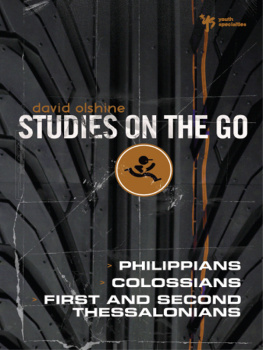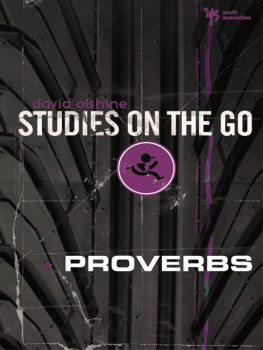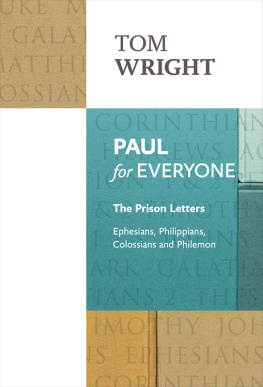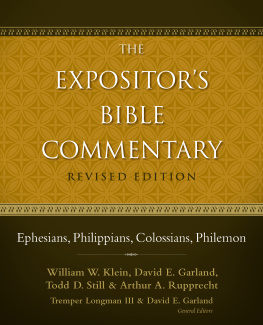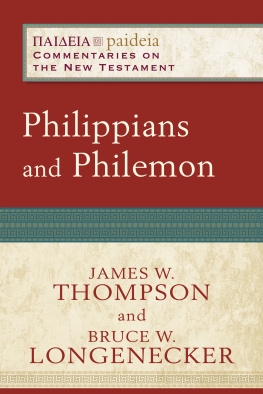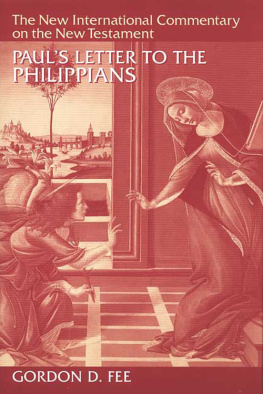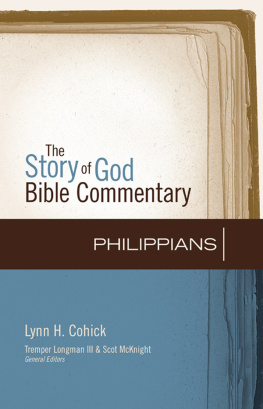
YOUTH SPECIALTIES
STUDIES ON THE GO: THE LETTERS OF PHILIPPIANS, COLOSSIANS, AND 1 AND 2 THESSALONIANS
Copyright 2009 by David Olshine
All rights reserved under International and Pan-American Copyright Conventions. By payment of the required fees, you have been granted the non-exclusive, non-transferable right to access and read the text of this e-book on-screen. No part of this text may be reproduced, transmitted, down-loaded, decompiled, reverse engineered, or stored in or introduced into any information storage and retrieval system, in any form or by any means, whether electronic or mechanical, now known or hereinafter invented, without the express written permission of Zondervan.
ePub Edition August 2009 ISBN: 978-0-310-86743-2
Youth Specialties resources, 300 S. Pierce St., El Cajon, CA 92020 are published by
Zondervan, 5300 Patterson Ave. SE, Grand Rapids, MI 49530.
ISBN 978-0-310-28549-6
All Scripture quotations, unless otherwise indicated, are taken from the Holy Bible, TodaysNew International Version. TNIV. Copyright 2001, 2005 by International Bible Society. Used by permission of Zondervan. All rights reserved.
Any Internet addresses (websites, blogs, etc.) and telephone numbers printed in this book are offered as a resource. They are not intended in any way to be or imply an endorsement by Youth Specialties, nor does Youth Specialties vouch for the content of these sites and numbers for the life of this book.
All rights reserved. No part of this publication may be reproduced, stored in a retrieval system, or transmitted in any form or by any means electronic, mechanical, photocopy, recording, or any other except for brief quotations in printed reviews, without the prior permission of the publisher.
Cover design by Toolbox Studios
09 10 11 12 13 14 20 19 18 17 16 15 14 13 12 11 10 9 8 7 6 5 4 3 2 1
DEDICATION
Dedicated to my wife and best friend Rhonda. You are a phenomenal support and a super mom who models the joy of being a follower of Jesus.
To David and Leslie Crocker for allowing me the use of your getaway place at the beach. What a blessing!
Major thanks to my writing and research team, graduates of Columbia International University in Columbia, SC: Nick Cunningham, Mark King, Trevor Miller, Anne Lord Bailey, and Rachel Olshineand to Rhonda Olshine, graduate of Asbury College and Asbury Seminary. This team has done a tremendous job of researching Scripture and writing with practicality and relevance for youth and young adults. Thanks for your diligent work and great insights. I couldnt have pulled this off without you!
CONTENTS
Maybe youve tried to lead a study and ended up not knowing what to say or where to take the lesson. These sessions have all of the best ingredients for helping students and adults connect with God and each other as they encounter Scripture. These studies work best in a small group format but can also be utilized in Bible studies, Sunday school, youth group, or even road trips and retreats.
Before each of the three sections youll find the Handy Tips and Insights: These three introductory sections help the leader or facilitator know some of the historical background and purpose of each letter.
Each session is then broken up into the following subsections:
1. Leaders Insight: A brief overview for each lesson to help the leader or facilitator understand the background and focus of the Bible text.
2. Share (warm-up questions): Before jumping in and studying the Bible, it helps to allow time for your group to connect relationally first. Warm-up questions are lighter and help your group get comfortable interacting with one another.
3. Observe (observation questions): These questions help your groupregardless of their Bible knowledgefocus on What does the passage say? and What is the author communicating? The goal is to bring to the surface what the students are noticing about the passage.
4. Think (interpretation questions): These are a set of questions helping your group consider what the author meant when he wrote the letters. The goal is to discover what the writer was saying to his audience.
5. Apply (application questions): These questions are focused on helping the group connect Gods truth to their own lives.
6. Do: An additional activity option that helps students experientially flesh out the lesson. The goal here is action, putting head knowledge into real-life practice.
7. Quiet Time Reflections: One reproducible handout page for each session providing additional exercises to help students personally reflect on the passages on a daily basis.
My hope is that these studies create an environment where students and adults experience community, meaning everyone, being valued and respected. The leaders job is to facilitate a safe place in which people can be known and share freely. The best small groups are fluid, organized, free-flowingwith each person sharing. May God bless you as you engage students in the process of applying Gods truth to their lives.
Blessings,
David Olshine
SECTION 1
THE LETTER TO THE PHILIPPIANS
WHO? This letter to the Philippians was written by Paul, a zealous Jewish leader, who had an encounter with Jesus that radically altered his life (Acts 7:51-60 and 9:1-31). His name was originally Saul and later became Paul (Acts 13:9). Besides Jesus Christ, few have shaped the course of history as the apostle Paul did. Paul was deeply rooted in the Jewish community when he encountered Jesus. One would think Pauls main calling after his conversion (or completion) to Jesus would be directed primarily to the audience he knew and loved the most, the Jewish people. And yet Jesus call was for Paul to immerse himself primarily in the Gentile, non-Jewish community. He won many Jewish people to Jesus, but the focus of his ministry was primarily with non-Jewish people.
WHERE? Philippi was the first church Paul planted in Europe around AD 50-52. He planted the church on his second missionary journey (see Acts 16:12-15). Philippi was located 10 miles from Neapolis on the Aegean Sea. The main highway to the west, the Via Egnatia, passed through Philippi and made this Roman colony a strategic place to share about Jesus. The city was founded and named after Phillip, the father of Alexander the Great.
WHEN? Paul authored this letter around AD 61-64, about 10 years after he founded this congregation and about four years after his last visit from his missionary journeys.
WHAT? Luke, the physician and author of the gospel of Luke, was pastor of this church the first six years. Paul dictated this letter to Timothy, a native of Lystra (Acts 16:1) whose mother was Jewish and father Greek. The apostle Paul led Timothy to Jesus (1 Timothy 1:2), and Timothy joined Paul on journeys to Troas, Philippi, Berea, and Thessalonica.
Paul starts his letters with a greetingGrace and peace to you and usually a prayer of thanks and mentioning some people he cares about deeply. Philippians is a letter of appreciation to this group of Christians. Paul mentions the Philippians partnership in the gospel (Philippians 1:5), which refers to their financial gift sent to Paul to help spread the good news.
Paul had a deep commitment and affection for the Philippian church. He referred to them as brothers and sisters, you whom I love and long for, my joy and crown (Philippians 4:1).
Written from prison, Pauls letter can be broken down into these chapter themes.
Chapter 1joy in suffering
Chapter 2joy in serving
Chapter 3joy in knowing Jesus
Next page
